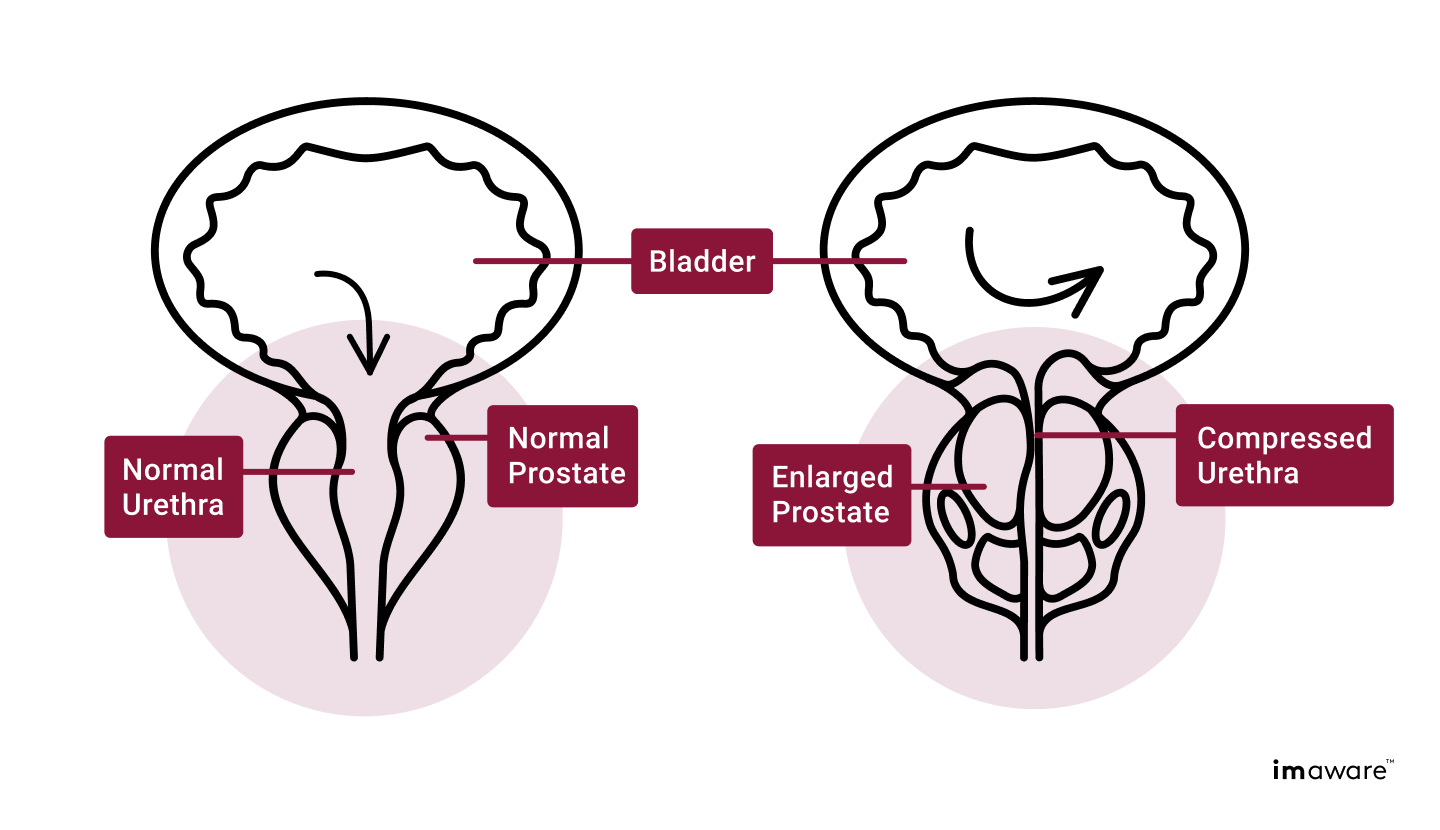Going to the bathroom is one of those everyday things you take for granted, until something changes. Problems with urination are relatively common in men over the age of 60, affecting about 1 in 3 men in this age range. Urinary problems can be caused by a number of different conditions, such as urinary tract infections, kidney stones, or an enlarged prostate. In some cases, problems with urination may indicate prostate cancer.
Things like a weak urine stream, urine coming out slowly, and feeling like you have to go but can’t, are all common problems that may be symptoms of an enlarged prostate.
This article will help you understand the most common male urination problems, what they mean, and what you can do if you are experiencing symptoms.
What makes it so hard to pee?
Problems with urination can often signal an enlarged prostate.
The prostate is a gland that produces liquid that is released along with sperm cells during ejaculation. The urethra – which is the tube that carries urine or ejaculate out of the body – runs through the prostate on its journey from the bladder to the penis.
The anatomy of the urethra and the prostate explains why an enlarged prostate can cause urinary symptoms:

When the prostate becomes enlarged, the pressure on the urethra can make it harder to pee. This pressure creates an obstruction – almost like a kink in a hose – and this is why it can take some men a long time to urinate. Straining to pee can cause the bladder muscles to react by getting stronger and thickening, which further contributes to urinary symptoms.
There is some evidence that shows people who sit longer are more likely to experience lower urinary tract symptoms, in other words, issues with urination. A 2018 Korean study found that prolonged sitting, as well as lower physical activity, were each associated with increased lower urinary tract symptoms.
What are the symptoms of an enlarged prostate?
Males typically experience the symptoms of an enlarged prostate before or during urination.
Symptoms can be categorized into irritative and obstructive symptoms. Irritative symptoms indicate an irritated bladder, and include frequent urination and strong urges to pee. Obstructive symptoms indicate difficulty with the flow of urine, and include trouble starting to pee, a weak urine stream, incomplete emptying of the bladder, and dribbling after urination.
Normal, healthy urination does not require pushing or forcing in any way. The urine should flow when a person relaxes their muscles, and the person should be able to empty their bladder completely. Forcing urine out is not healthy or normal, and may signal a problem that should be discussed with a doctor.
Symptoms of an enlarged prostate include:
- Increased frequency of urination – peeing 8 or more times a day
- Increased urgency – feeling like you have to pee right away
- Difficulty starting to go pee
- Weak urine stream
- Urination while sleeping
- Urinary incontinence – accidentally peeing
- Dribbling after urination
- Pain after ejaculation, or while peeing
What treatments are available?
There are many treatments for the symptoms of an enlarged prostate. Doctors will evaluate the level of symptoms you are experiencing, and keep a record of how these change over time, adjusting the treatment as necessary.
The most common treatment is watchful waiting, where you and your doctor monitor your symptoms while you use self-care methods to manage them. In cases where the symptoms are severe, there are medications available.
Self-care for prostate related urinary problems
Many of the symptoms of an enlarged prostate can be managed using self-care methods and lifestyle changes:
Bathroom habits
- Don’t hold your urine. Use the bathroom as soon as you feel the urge.
- Try going again right after finishing. Also known as “double voiding”, this can help reduce the urge to go again soon after.
- Squeeze excess urine out of the penis using your hands after finishing. Starting at the base of the penis, gently push up toward the tip to help release any urine that might be stuck in the urethra.
- Don’t rush going to the bathroom. Taking enough time can help you to fully empty your bladder when you urinate.
Fluid intake habits
- It may help to reduce your liquid intake slightly to reduce the amount of urine the body produces. It’s important to balance this with getting enough liquid to prevent dehydration.
- Consider drinking less water and other fluids before going out, especially if finding a bathroom will be challenging.
- Caffeine and alcohol are diuretics, meaning they increase the amount of urine the body produces. Reducing or avoiding caffeinated or alcoholic beverages may help reduce urinary symptoms. In particular, it may help to avoid these kinds of drinks with a few hours of bedtime.
Benign Prostatic Hyperplasia vs. Prostate Cancer
Benign Prostatic Hyperplasia, or BPH, is a medical term that refers to a condition that causes an enlarged prostate. The cause of BPH is related to aging. As men get older, it is common for the prostate to become enlarged with time.
“Hyperplasia” is a term for enlargement, and the term “benign” indicates that the enlargement is not harmful or cancerous. BPH is typically what is meant by the term “enlarged prostate”.
However, the prostate may also become physically enlarged as a result of prostate cancer. Many of the symptoms of prostate cancer overlap with the symptoms of BPH.
The symptoms of prostate cancer include frequent urination, difficulty with urine flow, straining to urinate, blood in the urine, blood in semen, and erectile dysfunction.
Although an enlarged prostate is often harmless, it is important to rule out prostate cancer as a potential cause of urinary symptoms.
Should I test for prostate cancer?
When a man is experiencing urinary problems, a doctor may wish to screen for prostate cancer.
If you've checked yourself for prostate cancer at home and, you feel uncomfortable with the results, it may be time to speak to a health professional.There are two methods doctors use to screen men for prostate cancer. The first is the dreaded digital rectal exam, where the doctor examines the prostate with his or her finger inserted into the rectum. While perhaps unpleasant, this short, simple test can help identify prostate cancer.
The second is a prostate cancer blood test, also called a Prostate Specific Antigen (PSA) test. This non-invasive test checks the blood levels of PSA. Elevated PSA levels may indicate prostate cancer. PSA tests are very sensitive, and can often detect prostate cancer in the early stages.
However, benign prostatic hyperplasia (enlarged prostate) can sometimes cause a false positive on a PSA test. Discussing your results with a doctor can help you to determine the cause of your urinary problems, and what actions you should take.
Conclusion
Urinary problems like having trouble starting urinating, feeling like you have to pee but can’t, or urine coming out slowly can all be symptoms of a common issue known as Benign Prostatic Hyperplasia, or an enlarged prostate. However, in some cases, these symptoms may indicate prostate cancer. If you are experiencing urinary problems, it is a good idea to speak to your doctor.














.svg)




